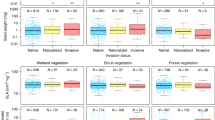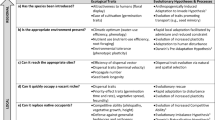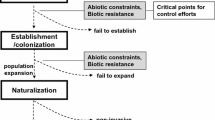Abstract
Adaptive responses of native species are important in enabling their persistence in the face of unprecedented biotic exchange. In the present paper I discuss how native species respond to invasive species both from a mechanistic and trait-based perspective. An earlier review by Strauss et al. (Ecol Lett 9:357–374, 2006) discussed a conceptual model of native species evolution in which the likelihood of an evolutionary response to an invader is dependent upon the strength of the selective pressure imposed (degree of variation in fitness between genotypes) and the adaptive capacity of the native (extent of pre-adaptation or genetic diversity). I aim to update and build upon this framework in light of new information on the interaction of phenotypic plasticity and evolutionary processes in adaptive responses of native species. Phenotypic plasticity can be a precursor to or an inhibitor of evolutionary responses and, under conditions of strong selection, phenotypic plasticity may enable adaptation where natives have a low evolutionary capacity. Based on current evidence, it is likely that phenotypic plasticity is the first front in native species adaptation, after which genetic changes occur via a genetic accommodation mechanism. Lastly, I review the literature on behavioural, morphological, physiological and life history trait changes of responding native species in light of this framework. Knowledge of the genetic and physiological underpinnings of adaptive responses in native species is limited and would aid in distinguishing the contributions of phenotypic plasticity and evolutionary change in future studies.



Similar content being viewed by others
References
Beckmann C, Crossland MR, Shine R (2011) Responses of Australian wading birds to a novel toxic prey type, the invasive cane toad Rhinella marina. Biol Invasions 13:2925–2934
Beckmann C, Shine R (2011) Toad’s tongue for breakfast: exploitation of a novel prey type, the invasive cane toad, by scavenging raptors in tropical Australia. Biol Invasions 13:1447–1455
Berger S, Wikelski M, Romero LM, Kalko EKV, Rödl T (2007) Behavioral and physiological adjustments to new predators in an endemic island species, the Galápagos marine iguana. Horm Behav 52:653–663
Bergum KE, Hild AL, Mealor BA (2012) Phenotypes of two generations of sporobolus airoides seedlings derived from acroptilon repens-invaded and non-invaded grass populations. Restor Ecol 20:227–233
Bezemer TM, Harvey JA, Cronin JT (2014) Response of native insect communities to invasive plants. Annu Rev Entomol 59:119–141
Blueweiss L, Fox H, Kudzma V, Nakashima D, Peters R, Sams S (1978) Relationships between body size and some life history parameters. Oecologia 37:257–272
Bourdeau PE (2013) Finely tuned response of native prey to an invasive predator in a freshwater system. Ecology (Durham) 94:1449–1455
Bourke P, Magnan P, Rodríguez M (1999) Phenotypic responses of lacustrine brook charr in relation to the intensity of interspecific competition. Evol Ecol 13:19–31
Brown C (2012) Experience and learning in changing environments. In: Wong B, Candolin U (eds) Behavioural responses to a changing world: mechanisms and consequences. Oxford University Press, Oxford
Callaway RM, Ridenour WM, Laboski T, Weir T, Vivanco JM (2005) Natural selection for resistance to the allelopathic effects of invasive plants. J Ecol 93:576–583
Caller G, Brown C (2013) Evolutionary responses to invasion: cane toad sympatric fish show enhanced avoidance learning. PLoS ONE 8:e54909
Carlsson NO, Sarnelle O, Strayer DL (2009) Native predators and exotic prey-an acquired taste? Front Ecol Environ 7:525–532
Carroll SP (2007) Natives adapting to invasive species: ecology, genes, and the sustainability of conservation. Ecol Res 22:892–901
Carroll SP (2008) Facing change: forms and foundations of contemporary adaptation to biotic invasions. Mol Ecol 17:361–372
Carroll SP, Dingle H, Klassen SP (1997) Genetic differentiation of fitness-associated traits among rapidly evolving populations of the soapberry bug. Evolution 51(4):1182–1188
Carroll SP, Klassen SP, Dingle H (1998) Rapidly evolving adaptations to host ecology and nutrition in the soapberry bug. Evol Ecol 12:955–968
Carroll SP, Dingle H, Famula TR (2003) Rapid appearance of epistasis during adaptive divergence following colonization. Proc R Soc Lond B Biol Sci 270:S80–S83
Carroll SP, Loye JE, Dingle H, Mathieson M, Famula TR, Zalucki MP (2005) And the beak shall inherit–evolution in response to invasion. Ecol Lett 8:944–951
Carthey AJ, Banks PB (2012) When does an alien become a native species? A vulnerable native mammal recognizes and responds to its long-term alien predator. PLoS ONE 7:e31804
Chivers D, Wildy E, Kiesecker J, Blaustein A (2001) Avoidance response of juvenile pacific treefrogs to chemical cues of introduced predatory bullfrogs. J Chem Ecol 27:1667–1676
Cipollini KA, Hurley SL (2008) Variation in resistance of experienced and naive seedlings of Jewelweed (Impatiens capensis) to invasive garlic mustard (Alliaria petiolata). Ohio J Sci 108(3):47–49
Courant AV (1994) Native pierine butterfly (Pieridae) adapting to naturalized crucifer. J Lepid Soc 48:168–170
Cousyn C, de Meester L, Colbourne JK, Brendonck L, Verschuren D, Volckaert F (2001) Rapid, local adaptation of zooplankton behavior to changes in predation pressure in the absence of neutral genetic changes. Proc Natl Acad Sci 98:6256–6260
Cox GW (2004) Alien species and evolution: the evolutionary ecology of exotic plants, animals, microbes, and interacting native species. Island Press, Washington
Crowder L (1986) Ecological and morphological shifts in Lake Michigan fishes: glimpses of the ghost of competition past. Environ Biol Fishes 16:147–157
Dai H, Lu X, Zhang J, Ding J (2014) Responses of a native beetle to novel exotic plant species with varying invasion history. Ecol Entomol 39:118–124
Denoel M, Dzukic G, Kalezic ML (2005) Effects of widespread fish introductions on paedomorphic newts in Europe. Conserv Biol 19:162–170
Dijkstra JA, Lambert WJ, Harris LG (2013) Introduced species provide a novel temporal resource that facilitates native predator population growth. Biol Invasions 15:911–919
Dostál P, Weiser M, Koubek T (2012) Native jewelweed, but not other native species, displays post-invasion trait divergence. Oikos 121:1849–1859
Eilts JA, Huxman TE (2013) Invasion by an exotic, perennial grass alters responses of a native woody species in an arid system. J Arid Environ 88:206–212
Ferrero-Serrano Á, Hild AL, Mealor BA (2011) Can invasive species enhance competitive ability and restoration potential in native grass populations? Restor Ecol 19:545–551
Fisk DL, Latta LC, Knapp RA, Pfrender ME (2007) Rapid evolution in response to introduced predators I: rates and patterns of morphological and life-history trait divergence. BMC Evol Biol 7:22
Flower CE, Long LC, Knight KS, Rebbeck J, Brown JS, Gonzalez-Meler MA, Whelan CJ (2014) Native bark-foraging birds preferentially forage in infected ash (Fraxinus spp.) and prove effective predators of the invasive emerald ash borer (Agrilus planipennis Fairmaire). For Ecol Manage 313:300–306
Fox CW, Lalonde RG (1993) Host confusion and the evolution of insect diet breadths. Oikos, 67(3):577–581
Freeman AS, Byers JE (2006) Divergent induced responses to an invasive predator in marine mussel populations. Science 313:831–833
Ghalambor CK, McKay JK, Carroll SP, Reznick DN (2007a) Adaptive versus non-adaptive phenotypic plasticity and the potential for contemporary adaptation in new environments. Funct Ecol 21:394–407
Ghalambor CK, McKay JK, Carroll SP, Reznick DN (2007b) Adaptive versus non-adaptive phenotypic plasticity and the potential for contemporary adaptation in new environments. Funct Ecol 21:394–407
Goergen EM, Leger EA, Espeland EK (2011) Native perennial grasses show evolutionary response to Bromus tectorum (cheatgrass) invasion. PLoS ONE 6:e18145
Greenlees MJ, Crossland MR, Shine R (2014) Larval interactions with an invasive species (the Cane Toad Rhinella marina) affect life-history traits in an Australian anuran (the Marbled Frog Limnodynastes convexiusculus). Australian Zoologist 36:424–428
Griffiths RA, Schley L, Sharp PE, Dennis JL, Román A (1998) Behavioural responses of Mallorcan midwife toad tadpoles to natural and unnatural snake predators. Anim Behav 55:207–214
Groman JD, Pellmyr O (2000) Rapid evolution and specialization following host colonization in a yucca moth. J Evol Biol 13:223–236
Grøndahl E, Ehlers BK (2008) Local adaptation to biotic factors: reciprocal transplants of four species associated with aromatic Thymus pulegioides and T. serpyllum. J Ecol 96:981–992
Hendry AP, Farrugia TJ, Kinnison MT (2008) Human influences on rates of phenotypic change in wild animal populations. Mol Ecol 17:20–29
Jensen C, Ehlers B (2010) Genetic variation for sensitivity to a thyme monoterpene in associated plant species. Oecologia 162:1017–1025
Kiesecker JM (1997) Population differences in responses of red-legged frogs (Rana aurora) to introduced bullfrogs. Ecology (Durham) 78:1752–1760
King R, Ray J, Stanford K (2006) Gorging on gobies: beneficial effects of alien prey on a threatened vertebrate. Can J Zool 84:108–115
Knapp RA, Matthews KR, Sarnelle O (2001) Resistance and resilience of alpine lake fauna to fish introductions. Ecol Monogr 71:401–421
Langkilde T (2009) Invasive fire ants alter behavior and morphology of native lizards. Ecology 90:208–217
Lankau RA (2012) Coevolution between invasive and native plants driven by chemical competition and soil biota. Proc Natl Acad Sci 109:11240–11245
Latta LC, Bakelar JW, Knapp RA, Pfrender ME (2007) Rapid evolution in response to introduced predators II: the contribution of adaptive plasticity. BMC Evol Biol 7:21
Lau JA (2006) Evolutionary responses of native plants to novel community members. Evolution 60:56–63
Lau JA (2008) Beyond the ecological: biological invasions alter natural selection on a native plant species. Ecology 89:1023–1031
Lee CE (2002) Evolutionary genetics of invasive species. Trends Ecol Evol 17:386–391
Lennartsson T, Tuomi J, Nilsson P (1997) Evidence for an evolutionary history of overcompensation in the grassland biennial gentianella campestris (Gentianaceae). Am Nat 149:1147–1155
Lesica P, Atthowe HE (2007) Identifying weed-resistant bluebunch wheatgrass for restoration in Western Montana. Ecolog Restor 25:191–198
Levine JM, Adler PB, Yelenik SG (2004) A meta-analysis of biotic resistance to exotic plant invasions. Ecol Lett 7:975–989
Llewelyn J, Phillips BL, Brown GP, Schwarzkopf L, Alford RA, Shine R (2011) Adaptation or preadaptation: why are keelback snakes (Tropidonophis mairii) less vulnerable to invasive cane toads (Bufo marinus) than are other Australian snakes? Evol Ecol 25:13–24
Losos JB, Schoener TW, Spiller DA (2004) Predator-induced behaviour shifts and natural selection in field-experimental lizard populations. Nature 432:505–508
Malausa T, Bethenod M-T, Bontemps A, Bourguet D, Cornuet J-M, Ponsard S (2005) Assortative mating in sympatric host races of the European corn borer. Science 308:258–260
McIntosh AR, Townsend CR (1994) Interpopulation variation in mayfly antipredator tactics: differential effects of contrasting predatory fish. Ecology 75:2078–2090
Mealor BA, Hild AL (2007) Post-invasion evolution of native plant populations: a test of biological resilience. Oikos 116:1493–1500
Mooney HA, Cleland EE (2001) The evolutionary impact of invasive species. Proc Natl Acad Sci USA 98:5446–5451
Nice C, Fordyce J, Shapiro A, Ffrench-Constant R (2002) Lack of evidence for reproductive isolation among ecologically specialised lycaenid butterflies. Ecolog Entomol 27:702–712
Nunes AL, Orizaola G, Laurila A, Rebelo R (2014) Morphological and life-history responses of anurans to predation by an invasive crayfish: an integrative approach. Ecol Evol 4:1491–1503
Nylin S, Slove J, Janz N (2014) Host plant utilization, host range oscillations and diversification in nymphalid butterflies: a phylogenetic investigation. Evolution 68:105–124
Oduor AM (2013) Evolutionary responses of native plant species to invasive plants: a review. New Phytol 200:986–992
Ortega Y, Greenwood L, Callaway R, Pearson D (2013) Different responses of congeneric consumers to an exotic food resource: Who gets the novel resource prize? Biol Invasions 16(8):1757–1767
Patten M, Campbell K (1998) Has brood parasitism selected for earlier nesting in the California Gnatcatcher. Western Birds 29:290–298
Pearl CA, Adams MJ, Schuytema GS, Nebeker AV (2003) Behavioral responses of anuran larvae to chemical cues of native and introduced predators in the Pacific Northwestern United States. Journal of Herpetology 37:572–576
Pease KM, Wayne RK (2014) Divergent responses of exposed and naive Pacific tree frog tadpoles to invasive predatory crayfish. Oecologia 174:241–252
Phillips BL, Shine R (2004) Adapting to an invasive species: toxic cane toads induce morphological change in Australian snakes. Proc Natl Acad Sci USA 101:17150–17155
Phillips BL, Shine R (2006) An invasive species induces rapid adaptive change in a native predator: cane toads and black snakes in Australia. Proc R Soc B Biol Sci 273:1545–1550
Quinos PM, Insausti P, Soriano A (1998) Facilitative effect of Lotustenuis on Paspalumdilatatum in a lowland grassland of Argentina. Oecologia 114:427–431
Reusch TBH, Williams SL (1998) Variable responses of native eelgrass Zostera marina to a non-indigenous bivalve Musculista senhousia. Oecologia 113:428–441
Robbins TR, Freidenfelds NA, Langkilde T (2013) Native predator eats invasive toxic prey: evidence for increased incidence of consumption rather than aversion-learning. Biol Invasions 15:407–415
Rodriguez LF (2006) Can invasive species facilitate native species? Evidence of how, when, and why these impacts occur. Biol Invasions 8:927–939
Rose KE, Louda SM, Rees M (2005) Demographic and evolutionary impacts of native and invasive insect herbivores on Cirsium canescens. Ecology 86:453–465
Rowe CLJ, Leger EA (2011) Competitive seedlings and inherited traits: a test of rapid evolution of Elymus multisetus (big squirreltail) in response to cheatgrass invasion. Evol Appl 4:485–498
Schlaepfer MA, Sherman PW, Blossey B, Runge MC (2005) Introduced species as evolutionary traps. Ecol Lett 8:241–246
Schlaepfer MA, Sherman PW, Runge MC (2010) Decision making, environmental change, and population persistence. In: Westneat D, Fox CW (eds) Evolutionary behavioral ecology. Oxford University Press, Oxford
Schlichting CD, Wund MA (2014) Phenotypic plasticity and epigenetic marking: an assessment of the evidence for genetic acommodation. Evolution 68:656–672
Scoville AG, Pfrender ME (2010) Phenotypic plasticity facilitates recurrent rapid adaptation to introduced predators. Proc Natl Acad Sci 107:4260–4263
Sebade BM, Hild AL, Mealor BA (2012) Native grasses collected from invasions demonstrate invasion resistance. Ecol Restor 30:209–217
Shine R (2012) Invasive species as drivers of evolutionary change: cane toads in tropical Australia. Evol Appl 5:107–116
Singer MC, Thomas CD, Parmesan C (1993) Rapid human-induced evolution of insect–host associations. Nature 366:681–683
Smith TB, Freed LA, Lepson JK, Carothers JH (1995) Evolutionary consequences of extinctions in populations of a Hawaiian honeycreeper. Conserv Biol 9:107–113
Strauss SY, Agrawal AA (1999) The ecology and evolution of plant tolerance to herbivory. Trends Ecol Evol 14:179–185
Strauss SY, Lau JA, Carroll SP (2006) Evolutionary responses of natives to introduced species: What do introductions tell us about natural communities? Ecol Lett 9:357–374
Strayer DL, Eviner VT, Jeschke JM, Pace ML (2006) Understanding the long-term effects of species invasions. Trends Ecol Evol 21:645–651
Tabashnik BE (1983) Host range evolution: the shift from native legume hosts to alfalfa by the butterfly, Colias philodice eriphyle. Evolution 37:150–162
Thomas R, Barnes A, Quan T, Beard M, Carter L, Hopla C (1988) Susceptibility to Yersinia pestis in the northern grasshopper mouse (Onychomys leucogaster). J Wildl Dis 24:327–333
Trussell GC, Smith LD (2000) Induced defenses in response to an invading crab predator: an explanation of historical and geographic phenotypic change. Proc Natl Acad Sci 97:2123–2127
Tuda M, Wu L-H, Yamada N, Wang C-P, Wu W-J, Buranapanichpan S, Kagoshima K, Chen Z-Q, Teramoto K, Kumashiro B (2014) Host shift capability of a specialist seed predator of an invasive plant: roles of competition, population genetics and plant chemistry. Biol Invasions 16:303–313
van Zwol JA, Neff BD, Wilson CC (2012) The influence of non-native salmonids on circulating hormone concentrations in juvenile Atlantic salmon. Anim Behav 83:119–129
Vanderwerf EA (2012) Evolution of nesting height in an endangered Hawaiian forest bird in response to a non-native predator. Conserv Biol 26:905–911
Vermeij GJ (1982) Phenotypic evolution in a poorly dispersing snail after arrival of a predator. Nature 299:349–350
Vourc’H G, Martin J-L, Duncan P, Escarré J, Clausen TP (2001) Defensive adaptations of Thuja plicata to ungulate browsing: a comparative study between mainland and island populations. Oecologia 126:84–93
Wells L (1970) Effects of alewife predation on zooplankton populations in Lake Michigan. Limnol Oceanogr 15:556–565
Whitlow WL, Rice NA, Sweeney C (2003) Native species vulnerability to introduced predators: testing an inducible defense and a refuge from predation. Biol Invasions 5:23–31
Wright JT, Gribben PE, Byers JE, Monro K (2012) Invasive ecosystem engineer selects for different phenotypes of an associated native species. Ecology 93:1262–1268
Zimmerman EC (1960) Possible evidence of rapid evolution in Hawaiian Moths. Evolution 14:137–138
Acknowledgments
I would like to thank Michelle Leishman, David Nipperess and Culum Brown for their helpful comments and ideas which greatly improved this manuscript. Thanks also to two anonymous reviewers whose critical eye greatly strengthened the arguments given.
Author information
Authors and Affiliations
Corresponding author
Rights and permissions
About this article
Cite this article
Berthon, K. How do native species respond to invaders? Mechanistic and trait-based perspectives. Biol Invasions 17, 2199–2211 (2015). https://doi.org/10.1007/s10530-015-0874-7
Received:
Accepted:
Published:
Issue Date:
DOI: https://doi.org/10.1007/s10530-015-0874-7




